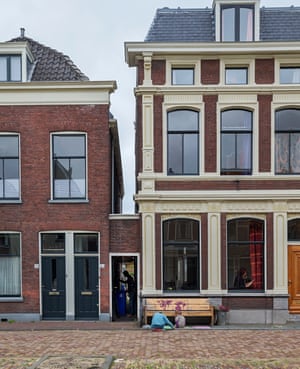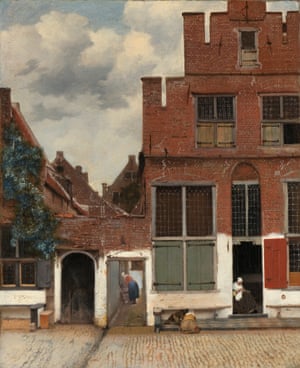Dutch art historian tells how he solved centuries-old mystery – and local people report a sightseeing invasion
Gordon Darroch
Thursday 26 November 2015
Few artists have left such a deep imprint on their birthplace as Johannes Vermeer on Delft. In the summer, tour parties weave through the Dutch town’s cobbled streets ticking off Vermeer landmarks. But until last week only the most devoted would have made a trip to the handsome townhouse at No 42 Vlamingstraat, noting that the artist’s aunt, Ariaentgen Claes van der Minne, once lived in the same spot and made her living selling tripe.
All that, however, has now changed. After two years of painstaking detective work, a Dutch art historian has identified the spot as the location of Vermeer’s Little Street, resolving a century-old mystery. “The whole street’s been talking about it,” said Lenie Gerbrands, whose house stands beside the spot where Vermeer sat four centuries ago, painting his aunt’s house across the water. “It’s a good piece of news to have in these difficult times. It’ll give the area a lift.”
Historians have been trying to identify the Little Street ever since Amsterdam’s Rijksmuseum acquired the painting, formally known as View of Houses in Delft, in 1921. Frans Grijzenhout, professor of art history at Amsterdam University, spent many months combing through land registers and legal documents to pinpoint the location.
His quest began when he came across a tax ledger dating from 1667 that gave exact measurements of the canals and houses in the town. The information was used to calculate how much households should pay towards the upkeep of the waterways. Grijzenhout realised it could be the key to identifying several well-known Delft street scenes.
In the 17th century Vlamingstraat was the heart of a poor neighbourhood, named after the Flemish migrants who lived there. Vermeer knew it well, having grown up in poverty nearby. His aunt and his sister both lived by the canal.
But almost nothing is left of the scene that Vermeer painted in 1658 or thereabouts. His aunt’s house at No 42, with its crow-stepped gables and the passageway known as De Penspoort (Tripe Gate), was torn down in around 1870. The house to its left has also been demolished and replaced. All that remains from Vermeer’s time is the canal itself, just out of view in the painting, and the doorway leading to Tripe Gate.
Historians could tell from the light in the painting that the facade of No 42 faced south-east, while the distance between painter and subject indicated it was a canal street rather than an alleyway. The distinctive double doorway between the houses was another significant pointer. Finally, the style of the house in Vermeer’s painting predated a devastating fire that raged through Delft in 1536, destroying much of the street.
“We think of Delft as an old town, but most of the buildings date from the 18th or 19th century,” said Grijzenhout. “When I first stood opposite the house two years ago I couldn’t see any of the features in the painting. But the dimensions of the house at No 42, the height and width, combined with the two doorways, matched the details in the book. I knew this had to be the place.” The clincher came when he found a map in Delft’s Prinsenhof museum made after the 1536 fire, which showed that No 42 Vlamingstraat was one of the few buildings in the area to have survived.

A reconstruction of Vermeer’s scene, at the location of the Little Street, as identified by a Dutch art historian.
The historian first visited the house back in February, but kept his true purpose a secret. “I wanted to be absolutely sure before I told the owners,” Grijzenhout said. “And I didn’t want to burden them with the knowledge. They were very friendly and helpful, but people find it difficult to keep these things secret.”
Grijzenhout kept up the pretence for several months. “He told us he was researching 19th-century buildings in the area,” said Myra Hillebrink, who lives in the house with her husband, Gijs, and their four children. “Then he came back in September with a copy of the painting and said: ‘Do you recognise this? This is where it was painted.’”
Hillebrink, 46, has already had a taste of her home’s new fame, having seen tourists and journalists tramp through the street in the days after the news broke. “I have to say we were taken aback by the response,” she said. “It’s very special to have this connection and the children are very excited about it, but I’m wondering when the hype will die down.”
Grijzenhout’s biggest source of doubt was the fact that the house had a family connection with Vermeer. “People thought it was naive or stupid to suppose it was the house just because his aunt lived there,” he said. “It seemed too good to be true. But it turns out it was correct. Vermeer was probably inspired by the memories he had of growing up in the area. The people in the painting aren’t models or members of his family; they’re not portraits. It’s just a typical street scene.”
Delft’s tourism officials are already discussing how to market the latest addition to the Vermeer canon. Tourist maps are being redrawn: until now most gave the probable location as Nieuwe Langendijk, a filled-in canal street running parallel to Vlamingstraat.
“It’s an opportunity for the whole town,” said Marjan den Boer of Marketing Delft. “Delft has three big selling points: the porcelain, William of Orange and Johannes Vermeer. The Japanese especially go in for Vermeer, I’m not quite sure why, but we get visitors from all over the world. We expect this will be another boost for tourism in Delft.”
And in other news:
On the Kromme Wall, Amsterdam.










No comments:
Post a Comment